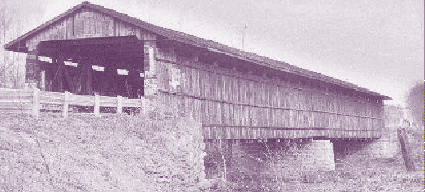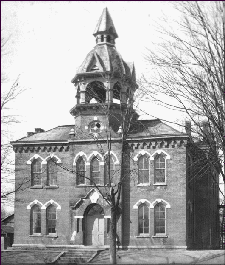Lockington Covered Bridge (A Ross file
photo)

The Lockington covered bridge over the Miami River, built in
1851, remains on the National Register of Historic Places nearly 9 years after it was
destroyed by fire. A listing of historic places plus the dates the properties were placed
on the register, and their register reference number appear on the National Register web site.
The bridge had been closed in 1985 because of rotting wooden flooring, crumbling
abutments and other problems, according to an October 18, 1989, Sidney Daily News account
of the fire. The bridge had cost $1,500, according to Shelby County engineer Steve
Hubbell. "The bridge was 170 feet long in two about equal spans,"
according to the news account. "The Lockington Covered Bridge was the oldest
bridge in the county and was the longest." A colored drawing of the bridge by
artist Ray Warren appeared in the July 1, 1976, U.S. Bicentennial issue of the Sidney
Daily News.
Hubbell’s office notified the Ohio Historical
Society that the bridge had been destroyed. "We had plans to build a park
around the bridge and we had an agreement with the Ohio Historical Society as part of
those plans," assistant county engineer Bob Geuy recently told Historical
Highlights. "Then we notified OHS that the plans were cancelled because the
bridge had been destroyed." The Ohio Historical Society’s Historic
Preservation Office assists in nominating Ohio sites to the National Register. "I
guess the reverse process, getting the bridge off the register, didn’t work,"
Geuy said, noting that OHS is the county engineer’s liaison with the National
Register.
The Lockington bridge will likely remain on the register, Nancy Johnson of the Ohio
Historic Preservation Office in Columbus said in late June. "Our office plans to
update the register for Ohio and we will try to include photographs of property even
though it may no longer exist," she said. "We think people will want to
see what it looked like even though the property was destroyed." The Ohio group
furnishes the listing information to the National Register maintained by the National Park
Service. Johnson said the listing will also appear on the Ohio Historic Preservation
Office web site.
Seventeen other Shelby County
historic sites are listed on the register: Anna Town Hall, Botkins Elementary School,
Emanuel Lutheran Church of Montra, Fulton Farm (residence of Society members Eric and Gay
Smith), Immaculate Conception Rectory in Botkins, People’s Federal Savings and
Loan Association, Port Jefferson School (gone), Sacred Heart of Jesus Rectory in
McCartyville, Shelby House in Botkins, Sidney
Courthouse Square Historic District, Sidney Walnut Avenue Historic District, Sidney
Waterworks and Electric Light Building (formerly owned by the Society), St. Michael
Catholic Church Complex in Fort Loramie, St. Patrick Catholic Church and Rectory in St.
Patrick, St. Remy Catholic Church in Russia, Whitby Mansion (GreatStone Castle), and Wilson-Lenox House on Houston Road (on the
property of Barbara and Marvin Ditmer).
In contrast to the Lockington bridge, one
defunct National Register site has been removed from the listing: Turtle Creek culvert and embankment west
of New Bern (Dayton Daily News, July 2, 1998).

National
Register of Historic Places
More than 68,000 listings make up the National Register which was authorized under the
National Historic Preservation Act of 1966. The program coordinates and supports public
and private efforts to identify, evaluate, and protect historic and archeological
resources, according to the web site.
The National Register cannot prevent owners from remodeling, altering, selling, or even
demolishing a listed property. But, a register listing does contribute to preserving
historic properties in several ways.
- Recognition that a property is significant
to the nation, state, or community.
- Consideration in the planning for federal or
federally assisted projects.
- Eligibility for federal tax benefits.
- Qualification for federal assistance for
historic preservation when available.
[ Back to Landmark Index ] |

